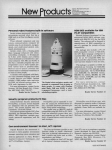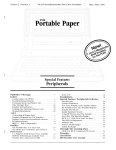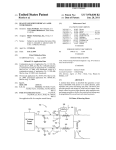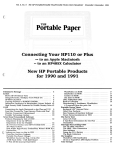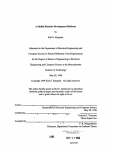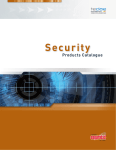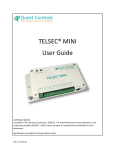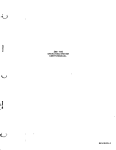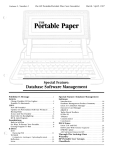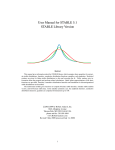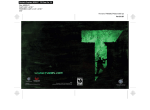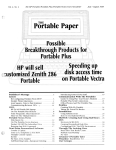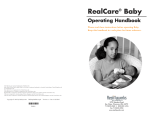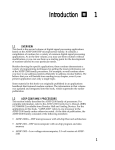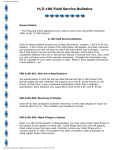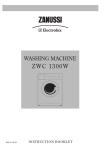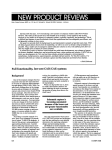Download New Products - IEEE Computer Society
Transcript
_evv 11 or J I 1n vI ouu Editor Richard Eckhouse Inc. ~~~~~~~~~~~Moco, C!91 Surfside Road, PO Box A S _% %u + :r.eckhouse 020655 CompmallMA Scituate, This month's New Products and Product Highlights were reviewed and selected by Frank P. Mathur, Caifomia State Polytechnic University at Porno. PLS offers three Laser publishing available for Unix Programming Logic Systems has announced three Prolog software products: micro-Prolog Professional for MS-DOS systems; a sigma-Prolog interpreter for Unix systems; and APES, Augmented Prolog for Expert Systems. micro-Prolog Professional runs on microcomputers under MS-DOS and is upward compatible with micro-Prolog 3.1, which has been in use for over four years. It features Macintosh-style windows and menus; window-handling primitives and full screen editor; a variety of programming environments such as English-like Simple syntax, Edinburgh DEC 10-style syntax, and Lisp-style syntax; memory for all variable names; a speed twice that of micro-Prolog 3. 1; and an OEM version for the production of turnkey systems. The ETP in-house publishing system! from ETP Systems is designed to provide laser printer typography for Unix computer users at a small fraction of the cost of traditional phototypesetting. The turnkey system includes a 300-dot per inch, eight-page per minute laser printer Prolog products sigma-Prolog runs on super-micro and mainframe computers under Unix and is upwardly compatible with micro-Prolog. APES is a suite of modules implemented in Prolog. By combining these modules, a range of logic programming environments can be constructed. In particular, APES can be used to construct logic-based expert systems. More generally, APES is a tool for developing logic programs. APES runs under the company's micro-Prolog or sigma-Prolog. APES version 2.0 will feature a redesigned window-/ menu-based environment, templates for whole rules and parts of rules to provide easily understood interaction, and explanations as well as the ability to access pages of explanatory text from disk. This version will be a compiler, compiling APES programs to run with micro-Prolog Professional. micro-Prolog Professional $395; retails for costs $695; and sigma-Prolog APE APES retails for $425. All prices are for a single-computer license, a reference manual, and Prentice-Hall's introduction book. For more information, contact Programming Logic Systems, 31 Crescent Dr., Milford, CT 06460; (203) 877-7988. fully integrated with controlling software. The company's / usr/ tools software package contains an enhanced deviceindependent troff, several macro formatting packages, a laser printer driver, a choice of industry-standard fonts, and a font-sizing program. Special facilities of / usr/ tools aid in the formatting of tables and mathematical equations. Because typesetting also yields more compact text, it reduces the size of manuals from 30 percent to 50 percent with proportional savings in printing or copying, shipping, and storage. In-house laser publishing reduces the cost of document preparation from the $45 per page usually associated with outside typesetting services to around $.07 per page for laser output. If extremely high resolution (over 700 dots per inch) is required for preparation of printing plates or for glossy sales materials, the ETP laser printer can be used as a proofing system prior to type- setting. The cost of a complete ETP in-house publishing system is around $13,000, which includes Galliard, Galliard Black, ETP Systems' laser publishing package enables Unix users to print high-quality documents that have the appearance of typeset manuscript with variable typefaces, multiple font sizes, italics, mathematical symbols, and table ruling. and Galliard Italic typeface fonts. Additional International Typesetting Corporation industry-standard fonts, such as Avant Garde, Eras, Franklin, and Souvenir, are available for $175 per face. A Software Subscription Service is also available to provide maintenance and ongoing product enhancements. For more information, contact ETP Systems, 10150 SW Nimbus Ave., Ste. E-2, Portland, OR 97223; (503) 639-4024. Reader Service Number 22 Real-time OS addresses 16M bytes The iRMX 286 real-time, multitasking, multiprogramming operating system from Intel can address up to 16M bytes of memory, expanding applications in process control, communications, and simulation. The iRMX 286 Operating System, Release 1.0, is application-source-codecompatible with Intel's iRMX 86 operating system. Applications developed on the iRMX 86 operating system can be ported to the iRMX 286 by recompiling application source code through use of iAPX 286 compilers. The iRMX 286 takes advantage of Reader Service Number 21 hardware traps provided by the 80286 September 1985 l microprocessor to speed debugging of new programs. If the amount of data exceeds the memory space allocated, for example, a hardware trap occurs and the error is reported. The operating system enables the user to easily locate the error. These hardware ~~~~~~~~~~~~~~~~~programming traps can automatically identify up to 90 programming errors. percent of typical available at an OEM license fee of $7500. For more information, contact Intel Corp., Literature Dept., W-232, 3065 Bowers Ave., Santa Clara, CA 95051; (408) 987-8080. Reader Service Number 23 69 Menu handles Modules aid accounting Micro Associates is offering a variety of accounting software packages for microcomputers, including Mica Job Cost, General Ledger Version 2.0, Productivity Interface, and Multicompany Manager. Job Cost, which runs on the IBM PC and compatibles under the PC-DOS and MS-DOS, on the HP 150, and on AT&T, Texas Instruments, Victor, Docutel-Olivetti, and Tandy computers, lets a user specify up to 999 components per job, while maintaining estimated, revised, and actual units and costs for each. Job characteristics can be totally defined by the user. General Ledger Version 2.0 offers enhancements such as more flexible budgeting capabilities, the ability to maintain ledgers for multiple companies, and the option to maintain ledger details for an entire year. Users can maintain independent ledgers for up to 10 companies and obtain both individual and consolidated statements. General Ledger Version 2.0 comes with a utility program to change the format of data files entered under General Ledger Version 1.0 to fit the new format. The Productivity Interface integrates accounting information from the Mica Accounting Series with most popular spreadsheet, database, and word processing applications. Using PI, data can be transfered to any program that will accept ASCII format, including Lotus 1-2-3 and dBase II. The Multicompany Manager for IBM PCs and compatibles permits financial records for several companies to be maintained on a single hard-disk system with only one copy of each Mica 1000 programs Magic Menu from DeereSoft, Inc., is a menu system that allows IBM PC, PC-XT, and PC-AT users to select and execute over 1000 application programs without dealing with DOS. It interfaces between the user and DOS Version 2.0 or higher, allowing any application to be performed with just a few keystrokes Reader Service Number 24 Reader Service Number 25 accounting applications package. For more information, contact Micro Associates, 2349 Memorial Blvd., Port Arthur, TX 77640; (409) 983-2051. Sequence screens allow automatic exeutionofdsecries of menu bentri while password security is available for all applications. Magic Menuse mem out resident, al se onstes without disk.it al id automatic acied for screen on blanking, dynamlc variables entries andvspeed entries for advanced users. For more information, contact DeereSoft, Inc., PO Box 1360, Melbourne, FL 32901; (305) 768-2477. vew New i*v Product Getting it all together Richard Eckhouse, New Products Editor In their latest release, the folks at US Robotics have put together an impressive telecommunications package. While possessing all the features one would expect of this genre, Telpac version 3.0 also provides menu windows, XMODEM, remote access, multiple phone directories, "photolog" to record a logon sequence, print spooler, multilevel security access, log file of calls made, ALT-key functions, conditional command files, and many other features too numerous to mention. In evaluating the software, I put it to the ultimate test-would I start using it over my other communications programs? I was immediately won over when it managed to log into a VAX system that required multiple prompts to get through two levels of Gandalf switches. The photolog feature duly copied the exchange and, when saved, allowed me to edit it to remove any extraneous or erroneous data. The same editor is used to edit phone directories and other menu entries, a feature often missing in similar programs. However, I was later disappointed to find Telpac did not support the VAX 70 gold function keys while emulating a VTIOO-a must for editing on VMS systems. I tried the remote access using my Radio Shack Model 100. Everything worked as expected, within the confines of what you can do using MS-DOS (since many programs directly access the hardware and cannot be remotely accessed). XMODEM worked equally well when I transmitted a file to CompuServe. I encountered two minor inconveniences having to do with flow control. Telpac has no scroll key, so you have to type CTRL-S and CTRL-Q to stop and start the flow. Other systems have a scroll function that allows them to stop the display while the remote host continues to send data to be held in a screen buffer. Not only is such a feature useful, it can save you connect time. The other inconvenience is the IN filter. You are allowed to specify any characters to be filtered out of the incoming data stream. Unfortunately, you can't remove all such characters (such as the DEL that a VAX system sends), generally only those that are printable. Also, you can't substitute another character for one that is filtered out. Finally, the only filter for output is LF. I'd prefer a more general system that allowed me to specify an IN/OUT filter that included pairs of hex values for what to remove and what to substitute, for example. I have one last criticism related to all such systems. While I have the ability to define a set of function keys, what I also want is the ability to redefine some of the standard keys. For instance, on the PC you use the BS key ( -) to delete to the left. On a VAX, you use the DEL key. I've seen only one system that allows these keys to be interchanged, depending on what host you log into. Telpac is easy to use, with extensive help windows. All commands may be executed using the windows, but the proficient user will soon begin to skip the windows and execute the commands directly. Oh yes, I am going to use Telpac as my main system. It is one of the best that I've come across. IEEE SOFTWARE Products aid in GAPP chip development NCR Corporation's Microelectronics Division has announced two products that will enhance the ability of users to develop software for the NCR45CG72, the systolic array processor chip known as the GAPP (Geometric Arithmetic Parallel Processor). The products are the NCR45GDS1, a GAPP PC Development System, and the NCR45GS2, a GAPP Simulator/Assembler software package. package. The PC Development System consists of a 13-inch board and development software. It is targeted for users who want to develop GAPP program code in a personal computer environment. It can run on an NCR Model 4 PC or any IBM PC-colnpatible computer, and it is available in two versions, MS-DOS and Venix/86. The PC board contains two GAPP devices configured to form a 12 X 12 processor array. Development software includes the GAPP Algorithm Language compiler and a program debugger which allows single- and multiple-step program execution. The GAPP Simulator/Assembler package is primarily for users who want to develop their GAPP software in either VAX/VMS or VAX/Unix environments. The Venix/86 (NCR45GDSl -VX) and pMS-DOS (NCR45GDSI-MS) versions of the PC Development System are available for $3500 each and include a PC board with two GAPP chips and development software that runs under the Venix/86 (VX version), or MS-DOS (MS version), operating systems. The Simulator/ Assembler is available in a VAX-compatible tape format and runs under VAX/VMS (NCR45GS2-VM) and VAX/ Unix (NCR45GS20-UX) for $995 each. GAPP (NCR45CG72) devices are available for $150 each in quantities of a thousand. For more information, contact NCR, Dayton, OH 45479; (513) 445-2075. Reader Service Number 26 Speech system allows 255 strokes per word Pronouncspeech i s or office a aplicatins. To The system allows the user an phrases. Each 128 words or short word with to 'may bethuassociated u'p ~~~~~~~~~~~~or 25 phrase kyros, tilored foringea macro program or standardizingall non- programs under natural voice ~~~~~~~~~~~~~~~~~related control. Pronounce, which consists of a PC board that fits into any IBM PC or compatible, software with predefined vocabularies for WordStar and Lotus 1-2-3, a microphone and user manual, retails for $895. For more information, contact MicroPhonics Technology, 234 SW 43rd St., Ste. B, Renton, WA 98057; (206) 251.9009. Reader Service Number 27 An alternative to windowing Galen Gruman, Assistant Editor Hammer Computer Systems' E-ZDOS-IT offers an alternative to traditional windowing programs. Rather than divide the screen like an electronic quilt, E-Z-DOS-IT toggles back and forth between programs, letting those not displayed execute in the background. The manufacturer calls it concurrent processing system-level software. The software features a user-friendly copy protection scheme. While only two copies are allowed from the master disk, the package comes with an "uninstall" option. If a user needs to reformat his hard disk, he can uninstall E-Z-DOS-IT back to the master disk without losing one of his two allowable copies. E-Z-DOS-IT is simple to set up and execute. From DOS, a user enters the command SETUP to get the setup menu. Several setup screens are allowed, although only one can be executed at a time. Function keys and TAB are used to move through the setup procedures. I was annoyed only that the screen I marked as the default screen (a handy feature in a system that allows several schemes for concurrent programs) was September 1985 neither recalled when I later reentered the setup program nor marked as the default by the software. That meant I had no way of knowing if the screen I wanted to be the default actually was-short of running the program. To label it as the default screen, a user must manually label the screen. After completing the setup, I returned to DOS and entered EZDOSIT, the command to run the concurrent program function. The first few times nothing hap pened. It turned out that my keyboard buffer extender, KBfix, was interfering with E-Z-DOS-IT. Out went KBfix. A few more tries resulted in memory overflow errors. I pared down the number of programs to run concurrently (I had a mixture of in-house Basic programs and commercial software for word processing and telecommunications) to fit within my system's available 256K RAM. Once this was done, E-Z-DOS-IT worked well, requiring only holding the CTRL and ALT keys plus a number representing the desired program to toggle back and forth from one application to another. When toggling between applications, the user can either type in the command to run the desired application or have E-Z-DOS-IT call up the program through a batch file specified in the setup. However, the batch file for the first application must be called AUTOEXEC.BAT, which is the main bootup batch file for IBM DOS. Consequently. auser can't have his terminal boot automatically with E-ZDOS-IT and any other initial processes and then go on to the first application desired. Instead, any initial processes must be entered by another batch file, either manually or as a toggle option in E-Z-DOS-IT. The manufacturer said E-Z-DOS-IT has been tested successfully on popular programs such as Lotus 1-2-3, WordStar, Smartcom II, Sidekick, and dBase III. However, the company said many users have reported problems running Basic programs. One customer service representative said I was lucky that my two Basic programs ran without a hitch. (The programs read text from a disk file, evaluate it, and write back to another file.) 71 Portable cuts retrieval time Hewlett-Packard has introduced The Portable Plus, an enhanced version of its notebook-sized portable computer for mobile professionals. Designed to complement and communicate with computers used in the office, The Portable Plus offers a full 25line by 80-character LCD display and popular plug-in ROM-based software. It comes standard with a 198K-byte ROM and a 128K-byte RAM, expandable to 896K bytes. Industry-standard MS-DOS software initially offered in ROM includes Lotus 1-2-3, Microsoft Word; MemoMaker/ Time Management; Executive Card Manager; and PC 2622, a program for emulating the HP 2622 and the DEC VT102 terminals. Programs are available separately as plug-in ROM cartridges or on 3¼/2-inch disks. The Portable Plus allows information to be stored and retrieved up to 10 times faster than with floppy diskettes and requires less power, according to the company. The reason is that it uses an electronic disk (E-disk), a batterypowered, RAM circuit designed to function like a disk drive, for nonvolatile storage of data and programs. ROM-based software built into The Portable Plus includes MS-DOS 2.11 and Personal Applications Manager, a friendly operating environment that eliminates the need for a user to learn MS-DOS. It also includes HP Link for communicating with the IBM PC and PC-compatibles, Diagnostics for checking out the system, and other utilities. Two expansion drawers at the bottom of The Portable Plus can be configured withROM additionalROM or RAM for aa with additional or total capacity of over 3M bytes of total memory. The ROM drawer accepts industry-standard CMOS 32K-byte or 128K-byte plug-in ROMs or 32KPnade availabeanversaiono alt Lisp fore EPROMs. MS-DOS, PC-DOS, CP/ M-86, and The optional Portable Desktop Link CP/MM-80 computers. (PDL) package, which includes an HPIL card, software and cables, allows Waltz Lisp's interpreter uses a shallow and stks garbage collon users to share data from available HP Touchscreen personal computers or IBM algorithm. With highly optimized assemblyode and nooely andlinkin PC and PC-compatible computers. bly code and no overlays and l eksg For example, a user working with the modules, the Portable Desktop Link option could oRAMprDebugging tools and ehandlin ofRAct remaingn tonl and load a spreadsheet (such as 1-2-3 from error-handlg facplgtes remab d onine a Lotus) from an HP Touchscreen all times. A prographmable undefined personal computer into The Portable Plus, takes it home for the night, and calls. An optional initialization file is load the revised spreadsheet from The loaded automatically at startup. Portable Plus back into the desktop This Waltz Lisp version features a system the next morning. full-screen editor WordStar-compatible, An optional built-in 300/ 1200-baud that permits the editing of files of any size from within the Lisp environment. modem allows access to HP 3000 miniProgram files can also be created using computers and IBM mainframes and to public databases including The Source ASCII text alsor any ASCII text editor. and the Dow Jones News/ Retrieval. Like Common Lisp, MacLisp, and The Portable Plus can link up with a other mainframe Lisps, Waltz Lisp has a variety of peripherals, including the HP complete suite of mappers, built-in pretty 9114A disk drive and the ThinkJet printing and level printing, fast sort and personal printer, merge, I/O streams, and advanced proThe HP 9114A disk drive is a batterygram control structures. It supports powered 3l2-inch drive that can read functions of type lambda, nlambda, from and write to both sides of a 710 Klexpr, macro, and both splicing and byte disk. In normal use, the drive will nonsplofu dg operate for eight hours before its character read macros. Waltz batteries need strings and integers up to 611 digits with The Portable Plus costs $2295. The se ectable radix. Portable Desktop Link retails for $175, theoSinarfae Any the manilaHP computers, and $150, IBM PCs and tion of binary files. Any number of files compatibles. The HP 9114A drive and be active simultaneously. Random ThinkJet printer retail for $795 and $495 can file access users to to an recharging.anls permits respectively, For more information, call the Hewlett-Packard dealer or sales office listed in the white pages of your local directory. Reader Service Number 28 The Portable Plus from Hewlett-Packard weighs less than 10 pounds, measures 13 X 10 X 3 inches and runs on batteries for up to two weeks of normal use on a single charge. It features an electronic disk and plug-in ROM-based software. 72 Waltz Lisp available for MS-DOS, CP/M append existing file, mix reading and writing operations, and instantaneously access any byte in a file. The MS-DOS version of Waltzincluding the 2.xto file Lisp fullycomplete supportsaccess system, the . ' structure. subdirectory The package comes with programs for file comparison, file sorting, advanced file operations, two virtual function definition schemes, and Clog Prolog, a small but complete Prolog interpreter. All programs are supplied in fully commented Lisp code. Waltz Lisp runs on any computer with MS-DOS 2.0 or higher and CP/ M-86 with a minimum 128K RAM. For Z-80based CP/ M systems, Waltz requires CP/ M 2.0 or higher with at least 48K RAM. Waltz Lisp retails for $169, including a 300-page manual and domestic shipping and handling charges. For more information, contact ProCode International, 15930 SW Coloniy PI., Portland, OR 97224, (1-800) 547-3000, Dept. 80. Reader Service Number 29 IEEE SOFTWARE




